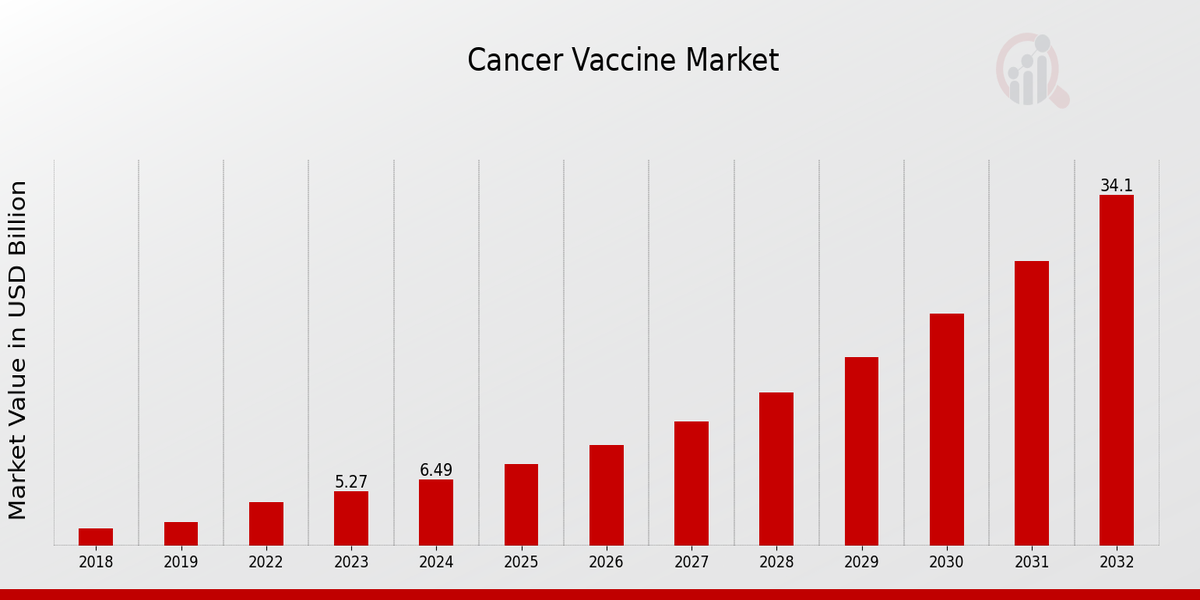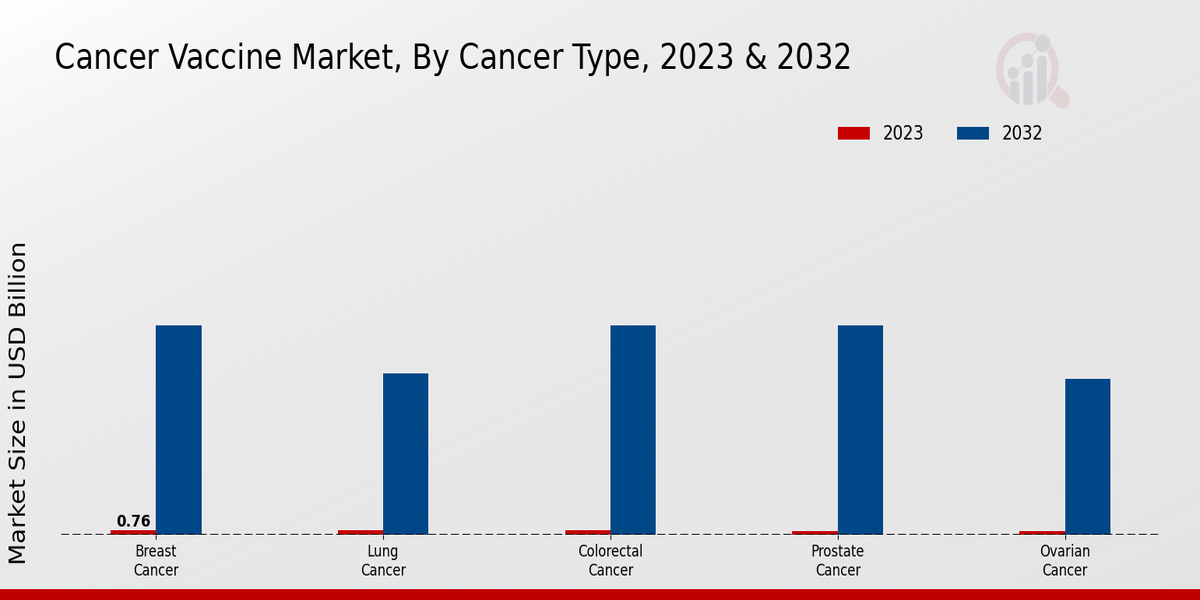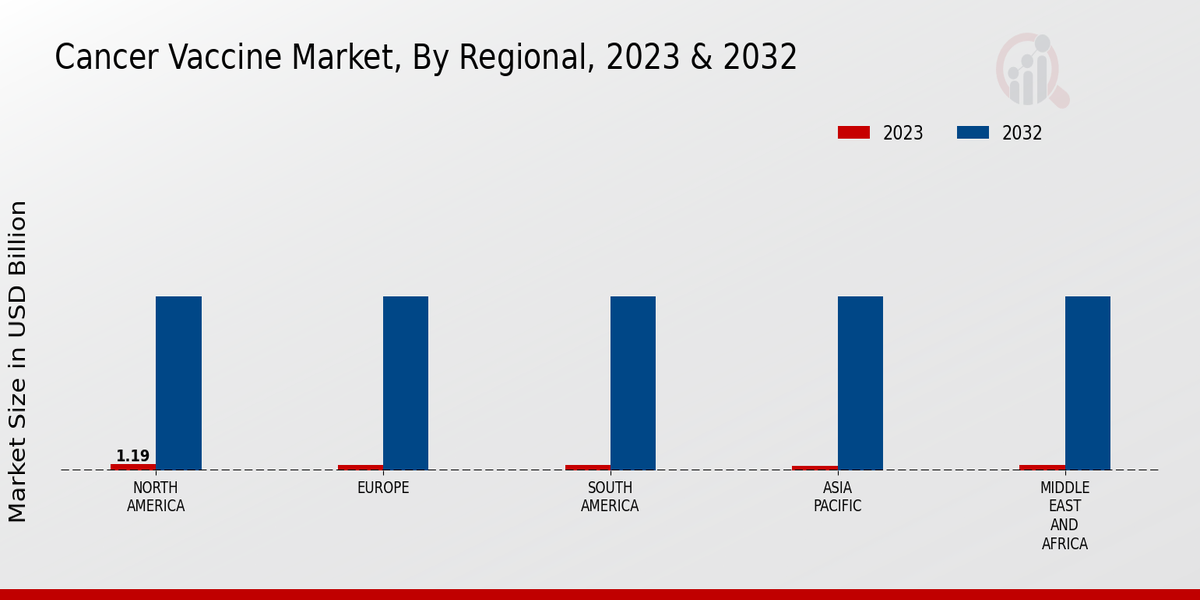Global Cancer Vaccine Market Overview
As per MRFR analysis, the Cancer Vaccine Market Size was estimated at 5.27 (USD Billion) in 2023. The Cancer Vaccine Market Industry is expected to grow from 6.49 (USD Billion) in 2024 to 34.1 (USD Billion) by 2032. The Cancer Vaccine Market CAGR (growth rate) is expected to be around 23.05% during the forecast period (2024 - 2032).
Key Cancer Vaccine Market Trends Highlighted
Growing prevalence of cancer, government initiatives to support cancer research, and technological advancements in vaccine development are driving the cancer vaccine market. The rise in cancer incidence and mortality rates, particularly in developing countries, is a major factor fueling growth.
Emerging opportunities lie in the exploration of personalized cancer vaccines, which tailor treatments to individual patient profiles. Increasing investments in precision medicine and immunotherapy are expected to create lucrative avenues for market players. Additionally, the development of mRNA-based cancer vaccines holds promise for future growth.
Recent trends include the integration of artificial intelligence and machine learning in vaccine development, enabling more accurate and efficient vaccine design. Moreover, collaborations between pharmaceutical companies and research institutes are fostering innovation and accelerating the pace of vaccine development. Ongoing research explores novel targets and vaccine platforms to enhance immune responses and improve patient outcomes in the fight against cancer.

Source: Primary Research, Secondary Research, MRFR Database and Analyst Review
Cancer Vaccine Market Drivers
Rising Prevalence of Cancer
One of the major drivers of the Cancer Vaccine Market Industry is the growing cancer incidence around the globe. For instance, according to the World Health Organization, in 2020, there were about 19.3 million cancer cases and about 10 million deaths from cancer worldwide, and these figures are expected to be doubled – 28.4 million new cancer cases and 17 million cancer-related deaths by 2040. Such a surge in cancer incidence is caused mostly by aging populations, unhealthy lifestyles, and environmental pollution.
Therefore, as the number of cancer patients increases, the need for effective cancer treatments, including vaccines, grows as well.
Technological Advancements in Cancer Vaccine Development
Technological advancements in the development of cancer vaccines are stimulating the cancer vaccine market industry. Many researchers are developing new and improved vaccines that are more efficient and have fewer adverse effects on patients. For instance, applications of genetic engineering and immunology have led to the introduction of personalized cancer vaccines that are adjusted to each patient’s specific genetic body structure.
These vaccines are more efficient than the previously developed vaccines, and one vaccine can now be used in treating a wide range of cancers.
Government Funding and Support
Government funding and support are another driver of the Cancer Vaccine Market Industry. Authorities all over the globe are investing more and more money in research and development as well as the manufacturing of vaccines to prevent and cure various forms of this disease. Moreover, the level of government involvement is on the rise, so it is one of the most important factors that drives the development of the industry.
Cancer Vaccine Market Segment Insights
Cancer Vaccine Market Cancer Type Insights
The Cancer Vaccine Market is segmented based on cancer type, which includes breast cancer, lung cancer, colorectal cancer, prostate cancer, ovarian cancer, cervical cancer, and melanoma. The breast cancer segment is estimated to hold the largest revenue share in the market by 2032. Further, the lung cancer segment is projected to grow at a rapid CAGR during the period of interest. Moreover, in terms of geography, the North American market is slated to dominate the industry over the next decade. Segment Referenced Above Breast Cancer Description of the Cohort: Possibly the most widespread form of cancer affecting women worldwide. Incidence and Mortality Rates from the Year 2020: The incidence rate for the year in question was 2.3 million, whereas 685,000 females perished from the disease.
Potential Contributors to Increasing Incidence of the Disease: The escalating incidence rate of breast cancer can primarily be attributed to the surge of obese individuals, anomalous hormonal levels, and gene markers. Prevention or Elimination Measures from Disease: There currently exist a number of methods to facilitate its early detection and treatment, such as mammogram screenings and biopsies. One of the most common types of cancer is prostate cancer, which is among the major problems related to men. In 2020, the number of new cases was around 1.4 million and deaths were about 375,000 worldwide.
It typically affects older men, with an increasing risk for males over the age of 65. It seems that the overall tendency to utilize prostate-specific antigen testing also positively influences the rates of prostate cancer due to screening and timely treatment. Another common type of disease is ovarian cancer, which is dangerous and may result in numerous deaths. By the end of 2020, an estimated 314,000 new cases and 207,000 deaths related to ovarian cancer were registered. This type of cancer is more common in postmenopausal women, with the risks of development increasing with age.
One of the greatest challenges is the lack of effective screening methods and tests. Thus, it is hard to diagnose the problem at its early stages, which leads to high mortality rates. Cervical cancer occurs in the cervix and is rather common in women. By the end of 2020, an estimated 604,000 new cases and 342,000 deaths occurred. It is also more common in women living in low- and middle-income countries. In a way, this type of cancer is associated with poverty, limited access to health care, and high rates of sexually transmitted infections. One of the recent and probably most effective interventions is a vaccine that protects women from human papillomavirus.
In 2020, around 324,613 new cases of this cancer were diagnosed globally, while 57,605 people died from it. It is produced by excessive growth of melanocytes, the cells that create melanin, and affects people with fair skin, those who suffered sunburns, and those whose families had a case of skin cancer. Besides, the use of sunscreen and other UV-protective means will cause a decrease in the number of patients in the future.

Source: Primary Research, Secondary Research, MRFR Database and Analyst Review
Cancer Vaccine Market Mechanism of Action Insights
The Cancer Vaccine Market is segmented by Mechanism of Action into Immunotherapy, Antibody-drug Conjugates, Oncolytic Viruses, Cancer Stem Cell Vaccines, and Peptide Vaccines. The Immunotherapy segment is expected to hold the largest market share in 2023 and is projected to grow at a CAGR of 23.05 % during the forecast period. The growth of this segment can be attributed to the increasing adoption of cancer immunotherapy drugs, such as checkpoint inhibitors and CAR T-cell therapies, which have shown promising results in treating various types of cancer, including melanoma, lung cancer, and bladder cancer.
The segment of Antibody-drug Conjugates is expected to grow at a CAGR of 21.56% during the forecast period. These are targeted therapeutics, which combine the specificity of an antibody with the cytotoxic killing power of drugs to kill tumor cells. These drugs have been found to be effective in treating various types of cancer, including breast cancer, lymphoma, and leukemia. The segment of Oncolytic Viruses is expected to grow at a CAGR of 19.87 % during the forecast period. These are genetically engineered or naturally occurring viruses that selectively replicate in cancer cells and destroy them.
They have been found to be effective in treating various types of cancer, including melanoma, brain cancer and pancreatic cancer. The segment of Cancer Stem Cell Vaccines is expected to grow at a CAGR of 18.65 % during the forecast period. These vaccines work by targeting the stem cells that have been recognized for the initiation and growth of tumors. They are effective in treating breast cancer, lung cancer, and colon cancer. The Peptide Vaccines segment is expected to grow at a CAGR of 17.98 % during the forecast period. These vaccines are made up of peptides from cancer cells and train the immune system to kill cancer cells.
They are effective in treating melanoma, prostate cancer and ovarian cancer.
Cancer Vaccine Market Therapeutic Modality Insights
The therapeutic modality segment of the cancer vaccine market is broadly classified into prophylactic and therapeutic vaccines. Prophylactic vaccines are designed to prevent cancer development in healthy individuals by stimulating the immune system to recognize and attack cancer cells before they can establish themselves in the body. Therapeutic vaccines, on the other hand, are used to treat existing cancers by stimulating the immune system to destroy cancer cells or prevent their growth. In 2023, the prophylactic vaccines segment held a larger market share due to the widespread adoption of vaccines against HPV and hepatitis B, which have been proven to reduce the incidence of cervical and liver cancers, respectively.
However, the therapeutic vaccines segment is expected to grow at a faster CAGR during the forecast period, driven by the development of novel immunotherapies and personalized cancer vaccines. The increasing adoption of combination therapies involving the use of both prophylactic and therapeutic vaccines is also anticipated to contribute to the growth of the therapeutic modality segment in the coming years.
Cancer Vaccine Market Regional Insights
The regional landscape of the Cancer Vaccine Market presents a diverse picture, with each region offering unique growth opportunities. North America leads the market, accounting for a significant share of the revenue in 2023. The region's advanced healthcare infrastructure, high prevalence of cancer, and strong research and development capabilities contribute to its dominance. Europe follows closely behind, driven by government initiatives to support cancer research and a growing focus on personalized medicine. The Asia-Pacific (APAC) region is projected to witness the highest growth rate over the forecast period.
Rapidly growing economies, increasing disposable income, and rising awareness about cancer prevention are fueling market expansion in this region. South America and the Middle East and Africa (MEA) regions are also expected to contribute to the overall market growth, albeit at a slower pace. As healthcare infrastructure improves and awareness about cancer increases in these regions, the demand for cancer vaccines is anticipated to rise.

Source: Primary Research, Secondary Research, MRFR Database and Analyst Review
Cancer Vaccine Market Key Players And Competitive Insights
Some of the essential features to be considered are Major players from the Cancer Vaccine Market, Revenues from the Cancer Vaccine Market, Company profiles and Industry Statistics. The Cancer Vaccine Market is highly competitive with many of the major players. A few of the Leading players in the market include Merck Co., Inc., GlaxoSmithKline plc, Pfizer Inc., and Sanofi Pasteur. They are continuously investing in Research and development to come up with New and innovative cancer vaccines.
There are also a few other smaller players who play a significant role in the market. The competition in this market is expected to remain fragmented- in the years to come with the entry of several new cancer vaccines. This is because there are different varieties of cancer vaccines- each one of which has its own set of benefits and drawbacks. There is a wide range of options available for healthcare providers and patients, which makes it difficult for any one player to acquire a strong hold on the market.
One of the key market players is Merck Co., Inc., for they have had a strong hold-over in the market for years – owing to their development and manufacturing of cancer vaccines and have a strong presence worldwide. Some of their products include Gardasil and Keytruda. Merck is a very strong player in the field of R&D and it is expected that it will launch many of the vaccines in the years to come. Another strong competition for the Cancer Vaccine Market is GlaxoSmithKline plc.
This Company, too, has a strong hold on the market as it sells several cancer vaccines, including Cervarix and Shingrix. GlaxoSmithKline plc also has a strong presence in the Research and Development field and is expected to launch several vaccines in the years to come. A few of the other strong competitors include Pfizer Inc., which came up with products such as Prevnar 13 and Bavencio Sanofi Pasteur, for it also produces several cancer vaccines, including Gardasil and Menveo.
Key Companies in the Cancer Vaccine Market Include
-
Merck
-
Pfizer
-
Roche Holding
-
BristolMyers Squibb
-
Johnson Johnson
-
Inovio Pharmaceuticals
-
Moderna Therapeutics
-
Eli Lilly and Company
-
Amgen
-
GlaxoSmithKline
-
Sanofi
-
AstraZeneca
-
Novavax
-
Bayer
Cancer Vaccine Market Industry Developments
The cancer vaccine market is projected to grow from USD 5.27 billion in 2023 to USD 34.1 billion by 2032, exhibiting a CAGR of 23.05% during the forecast period. The market growth is primarily driven by the rising incidence of cancer, increasing awareness about cancer prevention, and advancements in vaccine development. Key recent developments include:
In January 2023, Moderna announced positive results from a Phase 2b study of its personalized cancer vaccine, mRNA-4157/V940. The vaccine demonstrated a 44% reduction in the risk of disease recurrence or death in patients with high-risk melanoma.
In March 2023, Merck and Pfizer announced a collaboration to develop and commercialize a combination cancer vaccine targeting multiple tumor-associated antigens. The vaccine is expected to enter Phase 1 clinical trials in 2024.
In June 2023, BioNTech and Genentech initiated a Phase 2b clinical trial evaluating the combination of their mRNA cancer vaccine, BNT111, with Genentech's PD-L1 inhibitor, atezolizumab, in patients with advanced solid tumors.
These developments highlight the growing momentum in cancer vaccine research and development, with a focus on personalized and combination approaches to improve patient outcomes.
Cancer Vaccine Market Segmentation
Cancer Vaccine Market Cancer Type Outlook
-
-
Breast Cancer
-
Lung Cancer
-
Colorectal Cancer
-
Prostate Cancer
-
Ovarian Cancer
-
Cervical Cancer
-
Melanoma
Cancer Vaccine Market Mechanism of Action Outlook
-
-
Immunotherapy
-
Antibody-drug Conjugates
-
Oncolytic Viruses
-
Cancer Stem Cell Vaccines
-
Peptide Vaccines
Cancer Vaccine Market Therapeutic Modality Outlook
-
-
Prophylactic
-
Therapeutic
Cancer Vaccine Market Regional Outlook
-
-
North America
-
Europe
-
South America
-
Asia Pacific
-
Middle East and Africa
| Report Attribute/Metric |
Details |
| Market Size 2023 |
5.27(USD Billion) |
| Market Size 2024 |
6.49(USD Billion) |
| Market Size 2032 |
34.1(USD Billion) |
| Compound Annual Growth Rate (CAGR) |
23.05% (2024 - 2032) |
| Report Coverage |
Revenue Forecast, Competitive Landscape, Growth Factors, and Trends |
| Base Year |
2023 |
| Market Forecast Period |
2024 - 2032 |
| Historical Data |
2019 - 2023 |
| Market Forecast Units |
USD Billion |
| Key Companies Profiled |
Merck, Pfizer, Roche Holding, BristolMyers Squibb, Johnson Johnson, Inovio Pharmaceuticals, Moderna Therapeutics, Eli Lilly and Company, Amgen, GlaxoSmithKline, Sanofi, AstraZeneca, Novavax, Bayer |
| Segments Covered |
Cancer Type, Mechanism of Action, Therapeutic Modality, Regional |
| Key Market Opportunities |
Personalized cancer vaccinesCombination therapiesEmerging marketsTechnological advancementsmRNAbased vaccines |
| Key Market Dynamics |
1 Rising prevalence of cancer2 Technological advancements3 Immunotherapy’s efficacy |
| Countries Covered |
North America, Europe, APAC, South America, MEA |
Frequently Asked Questions (FAQ) :
The cancer vaccine market is expected to reach USD 34.1 billion by 2032, registering a CAGR of 23.05% from 2024 to 2032. The market size was valued at USD 5.27 billion in 2023.
North America is expected to dominate the cancer vaccine market throughout the forecast period. The region's large population, high prevalence of cancer, and well-established healthcare infrastructure contribute to its dominance.
The growing prevalence of cancer, advancements in vaccine technology, and increasing government and private funding for cancer research are the primary factors driving the growth of the cancer vaccine market.
Cancer vaccines are primarily used for the prevention and treatment of various types of cancer, including cervical cancer, breast cancer, lung cancer, and prostate cancer.
The key competitors in the cancer vaccine market include Merck Co., Inc., Pfizer Inc., GlaxoSmithKline plc, AstraZeneca plc, and Sanofi Pasteur.
The high cost of vaccine development, regulatory hurdles, and the need for long-term clinical trials are some of the challenges faced by the cancer vaccine market.
The development of personalized cancer vaccines, combination therapies, and the use of artificial intelligence in vaccine development are some of the emerging trends in the cancer vaccine market.
The cancer vaccine market is expected to register a CAGR of 23.05% from 2024 to 2032.
The cancer vaccine market was valued at USD 5.27 billion in 2023.
The cancer vaccine market is expected to reach USD 34.1 billion by 2032.

















